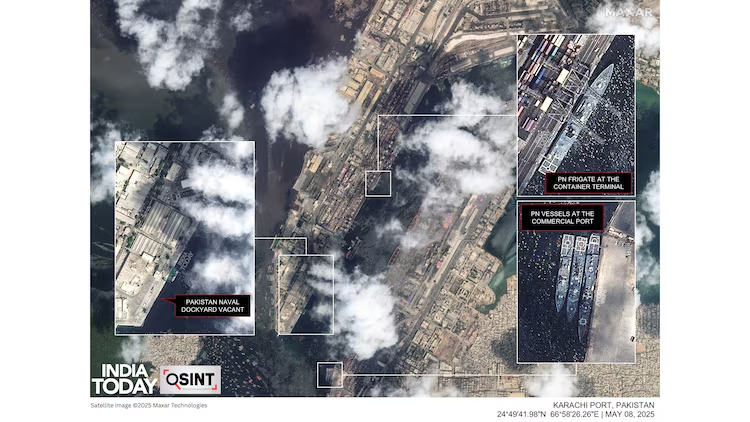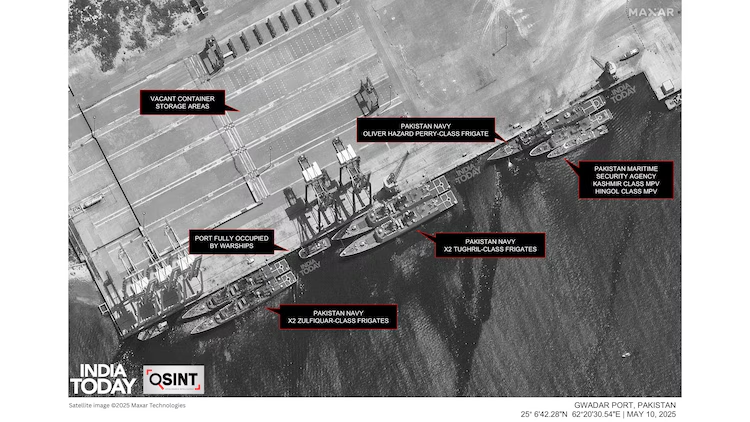Pakistan Navy's Defensive Posture Uncovered in Operation Sindoor Satellite Imagery

Recent analysis of commercial satellite imagery by India Today’s OSINT team indicates that during the height of Operation Sindoor in May, the Pakistan Navy adopted a defensive stance. Key naval vessels were relocated from Karachi's naval dockyard to commercial ports, and several were moved westward to Gwadar, a location nearly 100 kilometers from the Iranian border.
The images, captured between May 7 and May 10, reveal that Pakistan's leadership, despite public threats of retaliation following Indian attacks on terror targets, discreetly dispersed and concealed its naval forces to prevent further conflict.
On May 8, satellite photographs show Karachi’s naval dockyard unusually empty, with at least four Pakistan Navy warships observed at commercial cargo and container terminals near civilian ships. The vessels identified included PNS Alamgir, a Babur-class corvette, a Damen Offshore Patrol Vessel, and another frigate situated at a container terminal.
According to Vice Admiral SC Suresh Bangara (Retd), who once led a daring naval operation on Karachi, this strategy indicates “a sign of low operational readiness.” He suggested that positioning warships at civilian berths might be an attempt to avoid missile attacks by blending with commercial activities.
“Pakistan’s use of commercial air traffic to shield its military aircraft shows a willingness to risk civilian assets for survival,” Bangara added.

High-resolution imagery provided by Maxar Technologies confirms that by May 10, Gwadar had become a temporary naval base, despite its limited trade activity. The port, prominent in the China-Pakistan Economic Corridor, hosted two Zulfiquar-class frigates, two Tughril-class frigates, the US-built PNS Alamgir, and two maritime patrol vessels, alongside offshore replenishment tankers, while its container storage areas remained vacant.
Analysts highlight that this strategic movement underscores Islamabad’s concern over potential Indian strikes. Geo-intelligence researcher Damien Symon noted that the dispersal occurred as the Indian Navy's INS Vikrant embarked on its initial combat deployment in the Arabian Sea, prompting Pakistan to preemptively relocate its naval fleet westward.
The Pakistan Navy's dependency on Gwadar also suggested strain on its submarine capabilities, as several submarines were undergoing refits and maintenance, thereby weakening its underwater defense.
Symon commented that Gwadar had been “reconfigured as a fallback base,” with its 600-meter berth crowded with military vessels, providing temporary safety but increasing their visibility to satellite surveillance and potential attacks.

Meanwhile, the Indian Navy maintained a forward deployment in the Arabian Sea. Vice Admiral A.N. Pramod previously confirmed the readiness of forces to target Karachi and other strategic maritime locations if necessary.
Vice Admiral Bangara highlighted that despite the pause in Operation Sindoor, the campaign proved the success of coordinated planning.
“India executed a classic joint operation. We accomplished our goals without launching a single missile from the sea, conserving ammunition for any extended conflict,” he stated.
The satellite images serve as clear evidence that while Pakistan publicly discussed retaliation, its Navy largely stayed hidden, contrasting sharply with India's proactive and aggressive stance during Operation Sindoor.



















